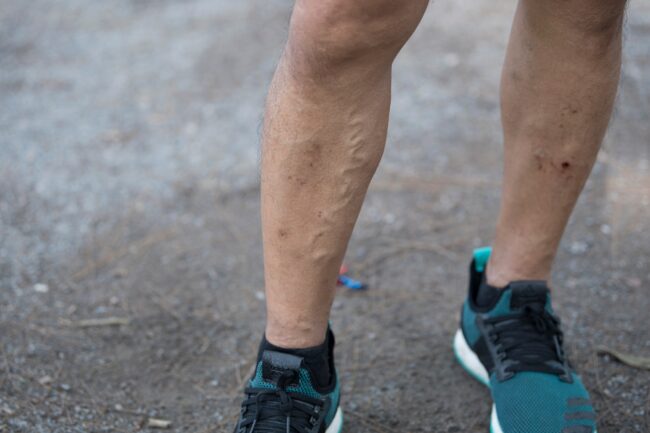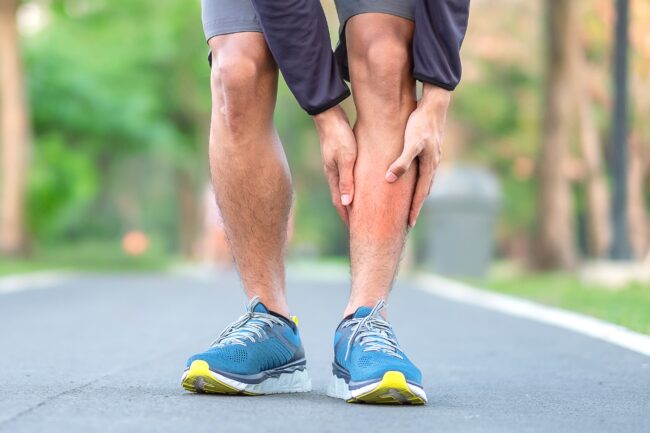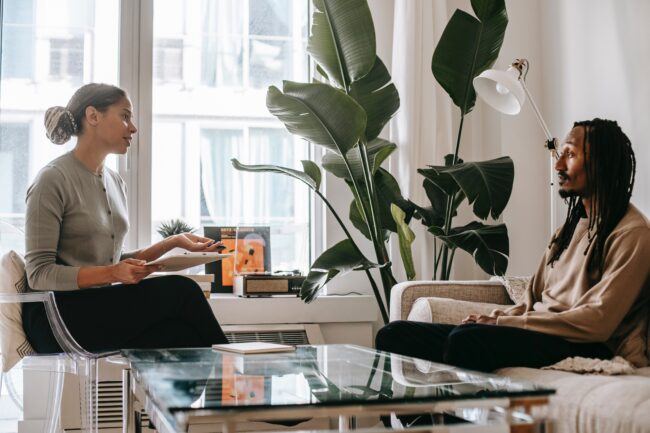Varicose veins are typically associated with women. So, you might be surprised to learn that they can affect men too.
And as varicose veins can be unsightly, painful, and sometimes even dangerous, it’s important to know how and why they might affect you and how to manage and treat them.
How likely are men to get varicose veins?

Close-up of man’s varicose leg veins
On average:
- 25% of people with varicose veins are men
- Over 40% of men over 70 develop them
- Around 10% of men have varicoceles (varicose veins in the scrotum)
So while it’s more common among women, it’s not rare to see in the male population.
Additionally, there are a few things that increase your chances of getting varicose veins. These include:
- Age
- Exercise regimen
- Profession (construction, driving, hospitality, and office work)
- Medical and family history
- Weight
- Heavy lifting
- Diet
You can learn more about these risk factors here.
But basically, varicose veins form when veins strain too much. This strain, whether caused by excess weight, regular wear and tear, standing too long or something else, results in your vein valves malfunctioning.
The valves, responsible for stopping blood from flowing backwards, can no longer do their job. So, your blood instead pools in the vein, stretching its walls and turning it varicose.
Where can varicose veins form in men?
As you might imagine, leg veins are most at risk. So it’s no surprise that’s where we see most varicose veins in men.
But, varicose veins can form anywhere there’s venous insufficiency, including your torso, arms, and legs.
And just as there are some varicose vein conditions that only affect women (like vulvar varicose veins), there is also one that only affects men. Known as varicoceles, this condition involves varicose veins forming in the scrotum.
How do I know if I have varicose veins?

Mid-shot of man’s legs, where the man is clutching his calf in pain
First, the veins will likely appear in the common problem areas like the thighs, calves, ankles, or scrotum. Second, they’ll generally be pretty easy to spot. Varicose veins are large, twisty, bulging, and dark blue or purple in colour.
And third, you might experience pain, swelling, itching, or burning in the problem area, or even muscle fatigue. Because remember, varicose veins mean reduced blood flow. And reduced blood flow means your muscles aren’t getting the oxygen they need to function at 100%.
Tip: Bulging veins do not always equal muscle mass. Some people mistakenly consider bulging veins on a man to mean that he is muscular and fit, but what he may, in fact, be suffering from is a venous disease or varicose veins.
What can men do to prevent varicose veins?
The best solution is to try and reduce the stress on your veins and keep your body as healthy as possible through a balanced diet and regular exercise.
For those who are vulnerable to the disease or have more than one of the risk factors listed above. The below may help to prevent the severity of varicose veins as well as relieve symptoms:
Exercise
- Low-impact exercise like swimming, cycling, and walking is best.
- You can also add leg and core workouts into your routine to strengthen those muscles and improve their function. Dead bugs, squats, and calf raises are all good options,
- Higher-impact exercises like running and team sports are fine to do, just be sure to protect your veins with compression garments.
Elevating legs
When you elevate your legs, ideally above heart level, it helps keep the blood from pooling in your lower legs and improves blood flow to the rest of your body.
Compression socks
Wearing varicose vein stockings for men will stimulate blood circulation to help prevent varicose veins and tired, achy legs.
Diet
Eat foods rich in fibre and vitamins C, D, and E. They’ll reduce strain on your leg and abdominal veins and keep your vein walls strong.
What happens if I don’t treat them?

A doctor talking to her male patient in an office.
It largely depends on how severe they are. If your condition is mild, there’s a chance you’ll just be stuck with a bulging vein and some achiness. But if your condition is more severe, it can easily worsen or lead to some dangerous conditions, like deep vein thrombosis.
If varicose veins form in the scrotum specifically, research shows that it could lead to infertility. Basically, the scrotum holds the testes and the veins responsible for supplying them with blood and oxygen. If that supply is impacted, the testes might have trouble producing sperm and testosterone, which are key to fertility.
Fortunately, though, not all varicoceles cause infertility. And there are some safe treatments available.
How do you treat varicose veins in men?
Vein stripping was once the only option (and an especially horrifying one if you have varicose veins in the scrotum). But now, vein specialists can perform minimally invasive procedures.
These include:
- Endovenous Laser Ablation, where we insert a small, laser-tipped catheter and seal the vein via heat energy.
- Radiofrequency Ablation, where we seal the varicose vein through bursts of radiofrequency.
- Medical superglue, where we inject medical-grade glue through a needle or catheter and glue the varicose vein shut
- Sclerotherapy, where we inject a sclerosant to agitate the varicose vein wall, causing clotting
- And ClariVein, where we use the ClariVein catheter to inject a sclerosant deeper into the problem vein.
After we seal the vein, your body absorbs it and reroutes your blood through healthy veins. We can generally perform these treatments within an hour. And as they’re minimally invasive and only require local anaesthesia, you can walk out of the clinic right after.
Call us on 04 2010 2637 or request an appointment here. We’ll be happy to talk you through your options.


